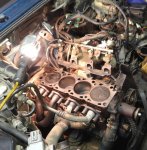Quote:"Because the oil feed being just behind it, I feel that is where the oil is coming from."
The oil would leak out at the head:block interface if the head gasket was bad. From the peekshures I don't see that. You will always have a dribble of oil that stays inside the 'cross head' passage, from the block, across to a cylinder head bolt where it can flow around the bolt up the the cam bearing and lifter/support gallery.
More likely, the cam cover gasket was leaking. If it was a bit loose, lots of oil will leak out. If you want to know why, remove the cam cover and start the engine. You will rust-proof your engine bay within a few seconds. There's a hurricane of oil flying around inside the cam cover when the engine is running. The gasket has to re-direct that oil, or keep it from seeping, and it is sometimes more than a cork gasket or rubber-cork gasket can retain. I have a full rubber gasket ready to install, but it's cold outside...
I would take a look at the valve stem seals and the valve guides for #4 cylinder. Also pay attention to how tight the valves are in the guides. If there's too much clearance, the seal may not handle the oil, and will feed it into the cylinder, causing oily deposit, fouled spark plug(s), and misfire. You might have noticed a puff of blue smoke when taking off from a stoplight. At idle, intake vacuum is high, and oil would tend to be pulled into the guide by vacuum, and then when you accelerate, it plopped into the cylinder and burned. Blue smoke is the result. More oil can accumulate with high vacuum making the smoke, which is occurring all the time, more readily visible.
I don't think a machine shop would disassemble a Lima head at no cost. From my experience doing one, you need to wear gloves due to the rough machined corners, and need a pry tool to depress the springs so the cam followers can be pried out. Repeat 7 more times, with a bit of angling each time to figure out where/how to pry. Then you get to pull the cam, and finally the valve keepers/springs, etc. Finally down to the stems and the ability to wiggle the valve to see if it is worn or has a worn guide.
The Lima will last a long time with minimal maintenance, so you might find the bottom end is fine.
tom
Add: What does the inside of the #4 exhaust manifold look like? How does it compare with the others? The oil on the piston could be from the cross head flow rather than rings or valve guides. If the port compares well, looks about the same as the others, likely you don't have a problem there.
Most times, a head will crack when it has been overheated. Do you know if that happened? What was the reason for disassembly? Did you do a compression test prior?














